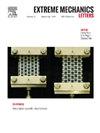Hydrostatic pressure suppresses the electrical breakdown of flexible-rigid interfaces under deep-sea
IF 4.5
3区 工程技术
Q2 MATERIALS SCIENCE, MULTIDISCIPLINARY
引用次数: 0
Abstract
High-voltage and high-power electronic components intended for deep-sea applications encounter various challenges, including high hydrostatic pressure, temperature fluctuations, and probable seawater ingress. Consequently, encapsulation of deep-sea electronics that provides both efficient electrical insulation and pressure tolerance is crucial. This study investigates the influence of high hydrostatic pressure up to tens of MPa on the electrical breakdown of the flexible-rigid encapsulation interface, using polydimethylsiloxane and FR-4 glass epoxy as experimental materials. The experimental results show that the interface breakdown strength increases with hydrostatic pressure, in which a rapid increase is observed at 0.1 MPa to 0.75 MPa, followed by a slower rise at 0.75 MPa to 30.0 MPa. To explain this phenomenon, the cavity discharge inception field and the enhanced local electric field at contact spots under hydrostatic pressure were calculated based on interfacial contact theory. At relatively lower pressures, cavity discharge predominates in driving the interface breakdown, and the rapid growth of cavity discharge inception field leads to the sharp increase in breakdown strength with hydrostatic pressure. Whereas at higher pressures, the insulation properties of contact spots become the dominant factor. Post-breakdown analyses, including optical microscopy and micro-CT imaging, reveal that high hydrostatic pressure suppresses damage propagation, such as material carbonization, electrode defects, and gas formation. These results indicate that hydrostatic pressure helps suppress the electrical breakdown of the flexible-rigid interface. This study provides insights into the electrical breakdown behavior of flexible-rigid interfaces under high hydrostatic pressure, offering implications for the encapsulation design and optimization of deep-sea electronic components.

静水压力抑制了深海柔性-刚性界面的电击穿
用于深海应用的高压和大功率电子元件面临各种挑战,包括高静水压力、温度波动和可能的海水侵入。因此,深海电子设备的封装既能提供高效的电绝缘,又能提供耐压能力,这一点至关重要。本研究以聚二甲基硅氧烷和FR-4玻璃环氧树脂为实验材料,研究了高达数十MPa的高静水压力对柔性-刚性封装界面电击穿的影响。实验结果表明,界面击穿强度随静水压力的增大而增大,在0.1 MPa ~ 0.75 MPa时,界面击穿强度快速增大,在0.75 MPa ~ 30.0 MPa时,界面击穿强度缓慢增大;为了解释这一现象,基于界面接触理论计算了静水压力作用下接触点的空腔放电起始场和局部电场的增强。在较低压力下,空腔放电对界面击穿起主导作用,空腔放电起始场的快速增长导致静水压力下击穿强度的急剧增加。而在较高的压力下,接触点的绝缘性能成为主要因素。击穿后分析,包括光学显微镜和微型ct成像,显示高静水压力抑制损伤传播,如材料碳化,电极缺陷和气体形成。这些结果表明静水压力有助于抑制柔性-刚性界面的电击穿。该研究为高静水压力下柔性-刚性界面的电击穿行为提供了见解,为深海电子元件的封装设计和优化提供了启示。
本文章由计算机程序翻译,如有差异,请以英文原文为准。
求助全文
约1分钟内获得全文
求助全文
来源期刊

Extreme Mechanics Letters
Engineering-Mechanics of Materials
CiteScore
9.20
自引率
4.30%
发文量
179
审稿时长
45 days
期刊介绍:
Extreme Mechanics Letters (EML) enables rapid communication of research that highlights the role of mechanics in multi-disciplinary areas across materials science, physics, chemistry, biology, medicine and engineering. Emphasis is on the impact, depth and originality of new concepts, methods and observations at the forefront of applied sciences.
 求助内容:
求助内容: 应助结果提醒方式:
应助结果提醒方式:


